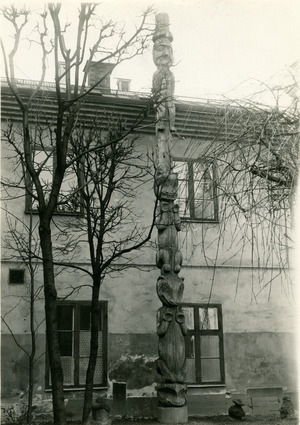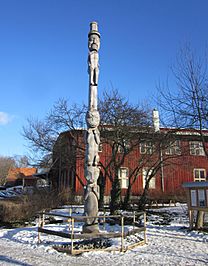Gʼpsgolox totem pole facts for kids
Quick facts for kids Gʼpsgolox totem pole |
|
|---|---|

The Gʼpsgolox pole in Stockholm, 1929.
|
|
| Material | Red cedar |
| Size | Height: 900 centimetres (350 in) |
| Created | 1872 by Haisla people, British Columbia |
| Present location | Misʼkusa (1872-1929), Stockholm (1929-2006), Kitamat (2006-2012), Kimano, Kitlope valley (2012-) |
The Gʼpsgolox totem pole is a very special nine-meter-tall pole created in 1872 by the Haisla people. This amazing pole has a long history. It traveled all the way to Sweden in 1929, where it was kept at the Museum of Ethnography. Later, in 2006, it was finally returned to the Haisla people. In 2012, the Haisla decided to let the pole naturally return to the earth, following their traditions for old and honored poles.
Contents
The Pole's Story and Meaning
The Gʼpsgolox totem pole has an important story behind it. In 1872, a serious illness spread through the Haisla Nation, located in what is now British Columbia. Many people became very sick, and sadly, many died.
Chief G’psgolox, who was the leader of the Eagle Clan, was very sad because his friends and family were gone. He went into the forest to seek help. There, he met two spirits named Tsooda and Zola. These spirits told Chief G’psgolox to go to a mountain at dawn the next day. They said he would see his people who had passed away and learn how to help those who were still living.
To thank the spirits for their help, Chief G’psgolox asked for a nine-meter-tall totem pole to be carved. This pole has three figures. The two figures at the bottom remember those who died. The figure at the top represents the T’sooda spirit, wearing a special hat.
Journey to Sweden
In 1928, a Swedish official named Olof Hanson asked the Canadian government if he could get a totem pole. In 1929, he was allowed to cut down the G’psgolox pole and take it to Sweden. Iver Fougner, who worked as an Indian agent (a contact person between the government and Indigenous peoples), helped cut down the pole.
Olof Hanson then gave the G’psgolox Pole to the Swedish National Museum of Ethnography in the same year. The museum kept the pole in storage for many years. In 1980, they finally had a proper building to display it. The pole was on display there for 25 years.
Asking for the Pole's Return
Some members of the Haisla Nation heard that their pole might be in Sweden. So, Louisa Smith and Gerald Amos traveled to Sweden to find out. When they confirmed it was the G’psgolox Pole, the Haisla Nation asked for it to be returned home.
In 1992, someone from the Museum of Ethnography visited the Haisla village in British Columbia. The Haisla people explained that the pole had been taken without their permission in 1929. They had been looking for it ever since. Now that it was found, they wanted it back.
The Haisla people offered to carve an exact copy of the totem pole to trade for the original. The museum agreed to this idea. In 1994, the Swedish government allowed the museum to give the totem pole back to the Haisla people. The only condition was that the new copy had to be exactly like the original.
In 2000, the Haisla community finished carving two copies of the pole. One was for Sweden, and the other was placed where the original G’psgolox Pole once stood. These new poles were carved by Henry Robertson and his nephews, Derek and Barry Wilson. The Haisla Nation also built a special center in Kitimaat Village to keep the original pole safe.
The Pole Comes Home
In 2006, after 77 years away, the G’psgolox pole finally arrived back at the Kitimaat Village in British Columbia. It was placed in a shopping mall so that school children could visit it. There, elders (respected older members of the community) shared the pole's history and stories with the children.
In 2012, the chief of the Kitlope Eagle clan decided it was time for the pole to complete its journey. It was moved to an old burial ground near its original location. There, it was left to slowly return to nature, as is the Haisla tradition for poles that have served their purpose for many years.



